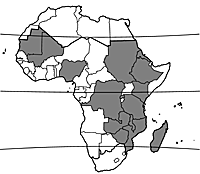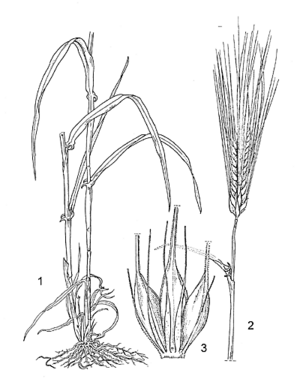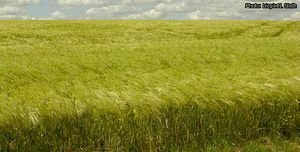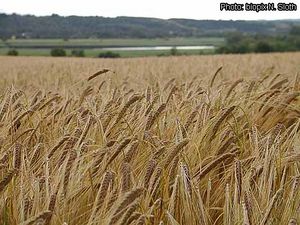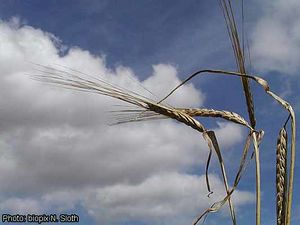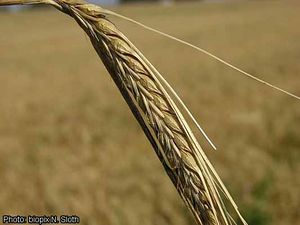Hordeum vulgare (PROTA)
Introduction |
| General importance | |
| Geographic coverage Africa | |
| Geographic coverage World | |
| Cereal / pulse | |
| Stimulant | |
| Medicinal | |
| Forage / feed | |
| Fibre | |
| Food security | |
- Protologue: Sp. pl. 1: 84 (1753).
- Family: Poaceae (Gramineae)
- Chromosome number: 2n = 14
Synonyms
- Hordeum sativum Jess. (1863).
Vernacular names
- Barley (En).
- Orge (Fr).
- Cevada (Po).
- Shayiri (Sw).
Origin and geographic distribution
Barley was domesticated in western Asia before 7000 BC. Cultivation spread to northern Africa and, moving upwards along the Nile, into Ethiopia, where it became one of the major cereals. It is not known exactly when barley reached Ethiopia, but it has been grown there for at least 5000 years. Barley reached southern Spain 4000–5000 BC and central and northern Europe, as well as India, 2000–3000 BC. It reached China 1000–2000 BC. Barley was cultivated in oases in the Sahara 100–300 BC, but seems not to have migrated southwards into West Africa before the 16th Century AD. Columbus took it to the New World. Nowadays it is grown over a broader environmental range than any other cereal, from 70°N in Norway to 44°S in New Zealand. In Ethiopia, Tibet and the Andes it is cultivated higher on the mountain slopes than other cereals. In tropical Africa it is mainly found in East Africa. In West Africa barley is grown as a cold season crop in the Sahel region and northern Nigeria. In Madagascar it is grown in the dry season.
Uses
On a worldwide scale barley is used, in order of importance, as animal feed, for malting (especially for beer brewing) and as human food. In the tropics and subtropics it is mainly grown for human food. In Ethiopia and Eritrea most of the grain is used for making the local pancake-like bread (‘injera’), but it is also made into porridge, soup and home-made alcoholic and non-alcoholic drinks. In Kenya and Tanzania it is more important for brewing. Grains are roasted or fried, and consumed as snack, particularly during social gatherings.
Barley straw is used as animal feed, for animal bedding, and as cover material for huts. Barley can be grazed during tillering or cut before maturity and directly fed to the animals or used for silage. In temperate areas barley grain is also fed to animals. By-products from the brewing process are also used in livestock feed.
Production and international trade
Annual world production of barley is 136 million t grains (mean of 1999–2003) from 54 million ha. Major producing countries are the Russian Federation, Germany and Canada with 16.2, 12.1, and 11.4 million t per year, respectively. In tropical Africa the main barley-producing country is Ethiopia, with 950,000 t of grain from 870,000 ha in 1999–2003, followed by Kenya (45,000 t from 20,000 ha) and Eritrea (24,000 t from 44,000 ha). In Ethiopia and Eritrea barley production is mainly for subsistence, and in Ethiopia the share of malting barley is about 2% of the total production. Small areas of barley (less than 4000 ha) are planted in Mauritania, DR Congo, Tanzania, Zambia and Zimbabwe. Most barley is consumed locally, with about 20 million t per year entering international trade in 1998–2002. The European Union, Australia and Canada are the largest exporters; Saudi Arabia, China and Japan the largest importers. In 1998–2002 the largest importers in tropical Africa were Zimbabwe and Ethiopia, with average annual imports of 8000 t and 3000 t, respectively.
Properties
The composition of barley per 100 g edible portion is: water 9.4 g, energy 1482 kJ (354 kcal), protein 12.5 g, fat 2.3 g, carbohydrate 73.5 g, dietary fibre 17.3 g, Ca 33 mg, Mg 133 mg, P 264 mg, Fe 3.6 mg, Zn 2.8 mg, vitamin A 22 IU, thiamin 0.65 mg, riboflavin 0.29 mg, niacin 4.6 mg, vitamin B6 0.32 mg, folate 19 μg and ascorbic acid 0 mg. The essential amino acid composition per 100 g edible portion is: tryptophan 208 mg, lysine 465 mg, methionine 240 mg, phenylalanine 700 mg, threonine 424 mg, valine 612 mg, leucine 848 mg and isoleucine 456 mg. The principal fatty acids are per 100 g edible portion: linoleic acid 999 mg, palmitic acid 411 mg, oleic acid 241 mg and linolenic acid 110 mg (USDA, 2004). Barley cannot be used to make leavened bread because of its low gluten content. The relatively high dietary fibre content makes barley interesting from a nutritional point of view, as increased amounts of dietary fibre have been shown to help in controlling diabetes, hyperlipidaemia, obesity, hypertension, coronary heart disease and various gastro-intestinal disorders. Barley is preferred to wheat and rye for malting because of the cemented lemma and palea, which protect the young plumule during germination, produce a firmer grain at the high moisture content needed for steeping and malting, and facilitate filtering.
Description
- Annual grass up to 120(–150) cm tall, tillering freely; root system consisting of 3–9 primary roots and adventitious roots; stem (culm) usually erect.
- Leaves 5–10 per culm, alternate, simple; leaf sheath glabrous, with large, overlapping auricles at apex; ligule 1–3 mm long, hyaline, ciliate; blade linear-lanceolate, 5–40 cm × 0.5–1.5 cm.
- Inflorescence a terminal cylindrical spike 5–10(–30) cm long, with groups of 3 spikelets attached alternately.
- Spikelets 1-flowered, with bisexual floret; glumes narrow, about half the length of the lemma, with fine bristles at the tip; lemma ovate, 9–11 mm × 3 mm, 5-veined, usually ending in an awn up to 15 cm long; palea as long as lemma, awnless; stamens 3; ovary superior, with 2 stigmas.
- Fruit a caryopsis (grain), ellipsoid, flattened and grooved on one side, varying in size according to cultivar, hairy at the tip.
Other botanical information
Hordeum comprises 32 species. Hybrids from crosses of Hordeum vulgare with other Hordeum species are sterile or anomalous. The large variability in barley led to many barley species being distinguished in the past. At present, the accepted view is that in barley evolution only a single species is involved, Hordeum vulgare, forming a crop-weed complex, in which the cultivated barley has been developed from original wild populations. Fertile hybrids between wild and cultivated types are easily obtained and occur naturally where the two grow together. Wild barley has been classified as subsp. spontaneum (C.Koch) Thell. (synonym: Hordeum spontaneum C.Koch), distributed in northern Africa, the eastern Mediterranean area and western Asia, and cultivated types as subsp. vulgare.
The variation in cultivated barley is overwhelming, with thousands of landraces and hundreds of cultivars. Cultivars can be divided according to the number of rows of grains (2 or 6), lax and compact spikes, or awned and awnless lemmas. All wild types have 2-rowed spikes, i.e. of the 3 spikelets at each node the two lateral ones are sterile, and only the central one develops a grain. Under domestication 6-rowed types appeared in which all 3 spikelets produce grains. Here, 2 genes are involved, both with multiple allelic series, but a single recessive mutation is enough for a 2-rowed barley to become 6-rowed. Cultivars grown in West Africa have 6 rows of grains in the spike, but in Ethiopia, especially in the upper highlands, a type of barley is found with 2 full rows and parts of other rows (‘irregular barley’). In ‘husked barley’ lemma and palea adhere to the grain at threshing, whereas in ‘naked barley’ the grain threshes free. A single recessive gene controls the latter character. Based on vernalization requirements barley is classified in winter and spring types.
Growth and development
The seedling emerges from the soil 5–6 days after germination. Tillers are produced on the main shoot until flower initiation. The number of tillers per plant is influenced by plant density, cultivar and environmental factors: a single plant usually develops 1–6 stems, but at low densities it may be several times as high. Time to flower initiation varies among cultivars, but in general barley flowers earlier than wheat. Barley is a quantitative long-day species, flowering earlier under longer photoperiods, but the photoperiod sensitivity differs between cultivars, ranging from very sensitive to almost insensitive. Flowers are predominantly self-pollinated, but cross-pollination can be as high as 10%. The grain ripens in 20–40 days. Barley can mature in a short season of 3–4 months, which is shorter than the season needed for other major cereals.
Ecology
Barley grows under a wide range of photoperiod, temperature and rainfall conditions, but is best adapted to temperate climates. It withstands high temperatures in dry climates and humidity in cool climates, but it is ill adapted to hot, humid climates, primarily because of its susceptibility to diseases. In Ethiopia, barley is cultivated at 1500–3500 m altitude, but mainly between 2000 m and 3000 m. In Kenya it is grown at 1500–3000 m altitude.
Winter barley types need vernalization by a period of low temperature (3–12°C). Barley is adapted to an annual rainfall ranging from 200 mm to more than 1000 mm. It is more drought-escaping, due to its early maturity, than drought-tolerant.
Well-drained fertile loams or light clay soils are best for barley production. Barley is more tolerant of alkaline soils than other cereals, but does not tolerate acid soils; a pH of 6.0–8.5 is generally acceptable. It is very sensitive to waterlogging. Some cultivars withstand up to 1% salt in the soil.
Propagation and planting
Barley is planted through direct seeding. The 1000-seed weight is 25–50 g. Before sowing, the land is ploughed to a depth of 10–15 cm. On smallholdings the land is prepared by animal traction. The seed should preferably be treated with fungicide to protect the crop from seed- and soil-borne diseases. Barley can be planted with drills, but on smallholdings seeding is usually by hand. When sowing with drills, the distance between rows is 15–35 cm, and the seed rate is 50–150 kg/ha. The sowing depth is 2–6 cm.
In the highlands of Ethiopia, barley is cropped twice a year. The main cropping season (‘meher’) is from June–December (with most of the rain in June–September), while the minor cropping season (‘belg’) is from February–June (most rain in March–April). Barley is the most suitable crop for ‘belg’-season production. Barley is usually sole-cropped, but in Eritrea and northern Ethiopia barley is often intercropped with wheat (the ‘hanfetz’ cropping system). In Eritrea farmers traditionally broadcast mixtures of 67% barley and 33% wheat; sometimes 50:50 mixtures are sown. In Ethiopia and Eritrea barley is a smallholder crop, but in Kenya it is grown on large-scale mechanized farms.
Management
Weeds cause economic losses in barley due to a reduced number of tillers and grains per spike. Resource-poor farmers weed by hand. The most widely used herbicide to control broad-leaved weeds in post-emergence spraying is 2,4-D. Barley requires about 25–35 kg N to produce 1 t of grain. Nitrogen can be applied before seeding or as topdressing after planting. Under dry conditions high rates of N application can cause yield reductions, whereas under favourable conditions high rates of N increase the risk of lodging and diseases. Excessive rates of N fertilization of malting barley may increase the protein level in the grain above the acceptable level.
In Ethiopia farmers usually grow barley in low-input systems, with minimal seedbed preparation and weeding, and without applying herbicides, fertilizers or insecticides. Low soil fertility and insufficient weed management are major constraints. In experiments at Holetta, application of 57 kg N and 25 kg P per ha led to a grain yield increase of up to 200%, whereas a single hand weeding at 35 days after emergence gave a grain yield increase of up to 20% compared to an unweeded crop. Lodging is also a common problem in Ethiopian barley cultivation. In West Africa barley is grown as a dry-season crop, often under irrigation.
Diseases and pests
Barley is affected by several viral and fungal diseases. The most important viral diseases are barley yellow dwarf virus (BYDV), transmitted by various aphid species, and barley stripe mosaic virus (BSMV), transmitted through seed or plant contact. Control measures for BYDV include the use of tolerant or resistant cultivars and aphid control, whereas BSMV can be controlled by using virus-free seed and resistant cultivars. Epidemics of African cereal streak, caused by maize streak virus (MSV) and transmitted by leafhoppers (Cicadulina spp.), have occurred in Kenya. Important fungal diseases include powdery mildew (Blumeria graminis f.sp. hordei, synonym: Erysiphe graminis f.sp. hordei), spot blotch (Bipolaris sorokiniana, synonym: Helminthosporium sativum), scald (Rhynchosporium secalis f.sp. hordei), scab (Fusarium spp.), rusts (Puccinia spp.), net blotch (Pyrenophora teres), barley stripe (Pyrenophora graminea) and smuts (Ustilago spp.). In Ethiopia and Eritrea, scald, blotches and rusts are the most important fungal diseases; the use of resistant cultivars is often the most effective control measure. Other control measures include crop rotation, the use of clean seed, seed treatment, fungicides, the destruction of infected plant material and deep ploughing. Several nematodes can parasitize barley: cereal cyst nematodes (Heterodera spp.), root-knot nematodes (Meloidogyne spp.), root-gall nematode (Subanguina radicicola) and root-lesion nematodes (Pratylenchus spp.). Control measures include crop rotation and fallow. Resistance breeding and the use of fungal pathogens have been successful against cereal cyst nematodes.
Barley is susceptible to attack by many kinds of pests, including aphids, shoot flies, grasshoppers, crickets, thrips, army worms, cutworms, and beetles and their larvae. Control may involve adjusting the planting date, and applying insecticides. In general, losses due to pests are relatively limited, with many of the pests causing greater damage as vectors of viruses, notably BYDV. Major storage pests of barley are insects and rodents.
Harvesting
Barley is ready for harvesting after reaching 35–40% kernel moisture. The crop is harvested by hand using a sickle or by combine. Threshing of malting and ‘naked’ barley requires special care to avoid too much broken seed.
Yield
Barley yields vary from 0.3 t/ha in dry years and in marginal environments to 10 t/ha in high input agriculture. In Africa average yields are 0.3–2.5 t/ha. In Asia and South America average yields are 1.5–1.7 t/ha, in North America 2.9 t/ha and in Europe 4 t/ha. Straw yields are equally important in many developing countries, but yield statistics are not available.
Handling after harvest
A high moisture content of barley grains at harvest favours the development of mycotoxins dangerous to humans and livestock. Before storing, grain has to be dried to 14% moisture or less. When barley is cultivated on small areas, it is common practice to keep selected spikes to provide the seed for the next crop.
Genetic resources
Current barley germplasm collections at ICARDA (International Center for Agricultural Research in the Dry Areas, Aleppo, Syria) contain more than 25,000 accessions. Since 1989 the ‘International Barley Core Collection’ has been developed by an international consortium including ICARDA. Many national programmes maintain their own working collections. The Institute of Biodiversity Conservation (IBC, Addis Ababa, Ethiopia) has a collection of more than 12,500 accessions. Smaller collections in sub-Saharan Africa are held in South Africa (National Department of Agriculture, Pretoria; Small Grain Institute, Bethlehem), Madagascar (Département de Recherches Agronomiques de la Republique Malgache, Antananarivo) and Kenya (National Genebank of Kenya, KARI, Kikuyu, Muguga). Barley shows orthodox storage behaviour.
Breeding
In barley breeding methods are used that are typical for self-pollinated crops. Until 1950 the main breeding method was either mass selection or pure line selection within landraces, which are still cultivated today in many countries, e.g. Ethiopia. New variability has been created by crossing, backcrossing and mutation. Recurrent selection is applied to increase recombination by crossing among F1’s and by repeating the crosses among a number of F2 plants or by using male-sterility genes. Mutation breeding with radiation or chemicals and double haploids have been widely used in barley breeding. Among the International Centres, ICARDA has the global mandate for assisting barley improvement programmes of National Agricultural Research Systems (NARS) in developing countries. Modern breeding has resulted in barley types with improved amino-acid composition (4.1% of the protein as lysine). The major emphasis is on producing cultivars resistant to diseases and pests and with adaptation to specific agro-ecological environments. Resistance to aphids has been incorporated into some cultivars. Ethiopian barley has been particularly useful in the improvement of nutritional quality and in supplying resistance to fungal and viral diseases (including powdery mildew, smuts, rusts, net blotch, scald, BYDV and BSMV). In Ethiopia, 9 improved barley cultivars were released between 1980 and 2000, but the adoption level is low (11% of the area).
The first genome-wide maps of barley were published in 1991, and more than 40 genome-wide maps have now been published.
Prospects
In general large improvements in barley production are possible through breeding of cultivars resistant to lodging and diseases. As most barley breeding has been for favourable environments, the potential of the crop in low-input agriculture is largely under-exploited. In the Ethiopian highlands, where barley is the preferred food crop, soil fertility has declined as a result of erosion and continuous cultivation. Under these circumstances it has been difficult to improve the locally adapted farmers’ cultivars. The staple Ethiopian cereal tef (Eragrostis tef (Zuccagni) Trotter), is taking over from barley as a result of favourable market prices, and high-yielding 6-rowed barley cultivars are becoming less important. In these areas breeding for early-maturing cultivars with higher resistance/tolerance to moisture stress than the existing ones might reverse the trend. Ethiopia has the potential to meet the local demand for malt barley and to produce for the African market. This can be achieved with the breeding and production of high-quality malt barley that meets the breweries’ standards, a concomitant increase in the number and capacity of malt-processing factories, and an efficient market structure.
Major references
- Ceccarelli, S. & Grando, S., 1996. Hordeum vulgare L. In: Grubben, G.J.H. & Partohardjono, S. (Editors). Plant Resources of South-East Asia No 10. Cereals. Backhuys Publishers, Leiden, Netherlands. pp. 99–102.
- Gebre, H. & van Leur, J. (Editors), 1996. Barley research in Ethiopia: past work and future prospects. Proceedings of the first barley research review workshop, 16–19 October 1993, Addis Ababa, Ethiopia. Institute of Agricultural research, Addis Ababa, Ethiopia & International Center for Agricultural Research in the Dry Areas (ICARDA), Aleppo, Syria. 195 pp.
- Hanelt, P. & Institute of Plant Genetics and Crop Plant Research (Editors), 2001. Mansfeld’s encyclopedia of agricultural and horticultural crops (except ornamentals). 1st English edition. Springer Verlag, Berlin, Germany. 3645 pp.
- Harlan, J.R., 1995. Barley. In: Smartt, J. & Simmonds, N.W. (Editors). Evolution of crop plants. 2nd Edition. Longman, London, United Kingdom. pp. 140–147.
- Hockett, E.A., 2000. Barley. In: Kulp, K. & Ponte, J.G. (Editors). Handbook of cereal science and technology. 2nd Edition. Marcel Dekker, New York, United States. pp. 81–125.
- Mathre, D.E., 1997. Compendium of barley diseases. 2nd Edition. The American Phytopathological Society, St. Paul, Minnesota, United States. 90 pp.
- Nevo, E., 1992. Origin, evolution, population genetics and resources for breeding of wild barley, Hordeum spontaneum, in the fertile crescent. In: Shewry, P.R. (Editor). Barley: genetics, biochemistry, molecular biology and biotechnology. CAB International, Wallingford, United Kingdom. pp. 19–44.
- Rasmusson, D.C. (Editor), 1985. Barley. American Society of Agronomy, Madison, Wisconsin, United States. 522 pp.
- Slafer, G.A., Molina-Cano, J.L., Savin, R., Araus, J.L. & Romagosa, I., 2002. Barley science: recent advances from molecular biology to agronomy of yield and quality. Food Products Press, New York, United States. 565 pp.
- von Bothmer, R., Jacobsen, N. & Baden, C., 1995. An ecogeographical study of the genus Hordeum. 2nd Edition. Systematic and ecogeographic studies on crop genepools 7. IBPGR, Rome, Italy. 129 pp.
Other references
- Asfaw, Z., 1990. An ethnobotanical study of barley in the central highlands of Ethiopia. Biologisches Zentralblatt 109(1): 51–62.
- Aw-Hassan, A. & Shideed, K., 2003. The impact of international and national investment in barley germplasm improvement in the developing countries. In: Evenson, R.E. & Gollin, D. (Editors). Crop variety improvement and its effect on productivity: the impact of international agricultural research. CABI Publishing, Wallingford, United Kingdom. pp. 241–256.
- Berhane, L., Yitbarek, S. & Fekadu, A., 1995. Evaluation of Ethiopian landraces for disease and agronomic characters. Rachis 14(1–2): 21–25.
- Briggs, D.E., 1978. Barley. Chapman & Hall, London, United Kingdom. 612 pp.
- Burkill, H.M., 1994. The useful plants of West Tropical Africa. 2nd Edition. Volume 2, Families E–I. Royal Botanic Gardens, Kew, Richmond, United Kingdom. 636 pp.
- Clayton, W.D., 1972. Gramineae. In: Hepper, F.N. (Editor). Flora of West Tropical Africa. 2nd Edition. Volume 3, part 2. pp. 277–574.
- Engels, J.M.M., Hawkes, J.G. & Worede, M. (Editors), 1991. Plant genetic resources of Ethiopia. Cambridge University Press, Cambridge, United Kingdom. 383 pp.
- Launert, E., 1971. Gramineae (Bambuseae - Pappophoreae). In: Fernandes, A., Launert, E. & Wild, H. (Editors). Flora Zambesiaca. Volume 10, part 1. Flora Zambesiaca Managing Committee, London, United Kingdom. 152 pp.
- National Research Council, 1996. Lost crops of Africa. Volume 1: grains. National Academy Press, Washington D.C., United States. 383 pp.
- Phillips, S., 1995. Poaceae (Gramineae). In: Hedberg, I. & Edwards, S. (Editors). Flora of Ethiopia and Eritrea. Volume 7. Poaceae (Gramineae). The National Herbarium, Addis Ababa University, Addis Ababa, Ethiopia and Department of Systematic Botany, Uppsala University, Uppsala, Sweden. 420 pp.
- Purseglove, J.W., 1972. Tropical crops. Monocotyledons. Volume 1. Longman, London, United Kingdom. 334 pp.
- Rehm, S. & Espig, G., 1991. The cultivated plants of the tropics and subtropics: cultivation, economic value, utilization. CTA, Ede, Netherlands. 552 pp.
- Sharpley, J., 1988. The foreign exchange content of Kenyan agriculture. IDS (Institute of Development Studies) Bulletin 19(2): 16–27.
- Tarekegne, A., Gebre, H. & Francis, C.A., 1997. Yield limiting factors to food barley production in Ethiopia. Journal of Sustainable Agriculture 10(2–3): 97–113.
- Thomas, W.T.B., 2003. Prospects for molecular breeding of barley. Annals of Applied Biology 142(1): 1–12.
- USDA, 2004. USDA national nutrient database for standard reference, release 17. [Internet] U.S. Department of Agriculture, Agricultural Research Service, Nutrient Data Laboratory, Beltsville Md, United States. http://www.nal.usda.gov/fnic/foodcomp. November 2004.
- von Bothmer, R., van Hintum, T., Knüpffer, H. & Sato, K., 2003. Diversity in barley (Hordeum vulgare). Developments in plant genetics and breeding No 7. Elsevier, Amsterdam, Netherlands. 280 pp.
- Williams, K.J., 2003. The molecular genetics of disease resistance in barley. Australian Journal of Agricultural Research 54: 1065–1079.
- Woldeamlak, A., 2001. Mixed cropping of barley (Hordeum vulgare) and wheat (Triticum aestivum) landraces in the central highlands of Eritrea. PhD thesis, Wageningen University, Netherlands. 220 pp.
- Yirga, C., Alemayehu, F. & Sinebo, W. (Editors), 1998. Barley-based farming systems in the highlands of Ethiopia. Ethiopian Agricultural Research Organization, Addis Ababa, Ethiopia. 117 pp.
Sources of illustration
- Ceccarelli, S. & Grando, S., 1996. Hordeum vulgare L. In: Grubben, G.J.H. & Partohardjono, S. (Editors). Plant Resources of South-East Asia No 10. Cereals. Backhuys Publishers, Leiden, Netherlands. pp. 99–102.
Author(s)
- S. Ceccarelli, ICARDA, P.O. Box 5466, Aleppo, Syria
- S. Grando, ICARDA, P.O. Box 5466, Aleppo, Syria
Correct citation of this article
Ceccarelli, S. & Grando, S., 2006. Hordeum vulgare L. In: Brink, M. & Belay, G. (Editors). PROTA (Plant Resources of Tropical Africa / Ressources végétales de l’Afrique tropicale), Wageningen, Netherlands. Accessed 18 December 2024.
- See the Prota4U database.

